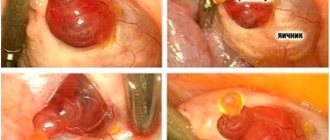In the life of almost every married couple there comes a time when planning a child. A woman is preparing for pregnancy, planning the timing of conceiving a child, and... Some people succeed the first time, others – after 3-4 months or later. The best time to conceive a child is the period of ovulation, which occurs approximately in the middle of the menstrual cycle, and the time of its occurrence can be calculated. When the cycle is regular, calculating the day of ovulation is quite simple - it occurs 12-15 days before the start of the next cycle. But what if the cycle is not regular, for example, one lasts 35 days, the second - 28, and the third - 31? How ovulation is calculated in an irregular cycle and what methods give the most accurate result - this is discussed in our article today.
Causes of irregular periods
A woman’s body is a rather fragile thing, and fluctuations in the menstrual cycle can be influenced by many factors.
Stress
The most common cause of cycle disruption in most cases is stress. Problems at work, at home, constant lack of sleep, and even severe overwork over a long period - and the body is under stress, and the cycle fails.
Diseases
Infectious and non-infectious diseases of internal organs, both in the sexual sphere and in others, can also cause an irregular cycle. Therefore, it is very important to do a complete examination of the body before planning a pregnancy - it can reveal hidden diseases and, possibly, normalize the cycle.
Sudden weight fluctuations
Too sharp fluctuations in weight lead to restructuring of the body, and the reproductive system also does not stand aside. Therefore, if a woman plans to lose weight, she should remember that this may affect the menstrual cycle.
Hormonal disbalance
The causes of hormonal imbalance can be both the above reasons and diseases of the thyroid gland. In case of hormonal imbalance, it is not recommended to plan a pregnancy until the hormonal levels return to normal.
Pharmacy test
Using special tests, you can determine the day of expected ovulation. But the problem is that with an unstable cycle it is difficult to determine the day of testing. In this case, you need to take the shortest menstrual cycle over the last six months as a basis.
The ovulation test is similar in action and use to the pregnancy test, but it reacts to the level of luteinizing hormone in the urine, and not to hCG.
To obtain results, you need to place the test strip under a stream of urine and wait for a while. Then compare the result with the control line. There was no ovulation if the strip is paler than the control line. In this case, the test should be done after a few days. If the strip has the same color as the control line or is darker, this indicates that ovulation has occurred or will occur within 1-1.5 days.
The method is simple and does not require time, but it is expensive, especially if we are talking about an irregular cycle. Many tests will be required, and they are expensive. Another disadvantage of the test is that for some reasons it can show a false result, for example, with polycystic ovary syndrome, the level of lutein changes.
Methods for determining ovulation during an irregular cycle
There are several methods by which you can determine when ovulation begins. With an irregular cycle, it is somewhat more difficult to determine, but nevertheless possible. For a more accurate determination, it is better to use several methods at once.
Calendar method
The most popular and accessible, but not the most accurate method in the case of irregular cycles. The menstrual cycle consists of two periods: before ovulation, when the egg matures, and after ovulation, when the body prepares for a new cycle, since fertilization has not occurred. If the cycle is irregular, then data for the last six months is needed for calculation. You need to subtract 14 units from the longest and shortest cycles. Between these days you can expect ovulation. It should be noted that in this case the difference between the longest and shortest cycle should be no more than a week.
Laboratory blood test method
This method involves taking a test to determine the level of progesterone in the blood.
With this method, blood is donated several times per cycle. Progesterone gradually increases and remains high until the next cycle. Ovulation detection: using test strips
Ovulation test
This method is similar to the method of determining pregnancy using test strips, only the test strips in this case will be for ovulation. They respond to luteinizing hormone, which begins to be produced two days before ovulation and allows the mature egg to be released. As is the case with hCG, which is produced by the body during pregnancy, if a woman has diseases in which this hormone increases, then this method will not work.
Basal temperature tracking.
A not very convenient, but relatively accurate way to determine the time of ovulation is to track basal body temperature. A day before ovulation occurs, body temperature will drop, and after 6-12 hours it will rise by about half a degree. This method has only one, but very significant drawback - you need to measure body temperature every day for at least three to four cycles at the same time of day under the same conditions - preferably in the morning, without getting out of bed.
Ultrasound of the ovary
This method belongs to the category of “visual”.
In the first half of the cycle, the follicle in the ovary grows, and when it reaches about 2 centimeters, it breaks through and the egg begins to descend through the tube into the uterus. On the day of ovulation, you can usually see a small gap in the ovarian capsule. This method is the most accessible and accurate. Ultrasound also evaluates the growth of the endometrium - it is its quantity and presence that determines the possibility of egg attachment. Determination of ovulation : using ultrasound
Possibility of getting pregnant with irregular periods
Irregular menstruation directly affects the ability to conceive a child. At the same time, women cannot determine the favorable period using standard calculations.
The best option in this case is to plan the pregnancy for a long time, which in most situations gives a positive outcome.
The menstrual cycle and pregnancy are interconnected. Women with infrequent bleeding find it more difficult to conceive; they are wondering whether it is possible to get pregnant with irregular periods. Doctors give a positive answer: if fertilization fails, it can happen quickly or you will have to wait.
Pregnancy with an irregular cycle depends on the cause of menstrual imbalance.
If menstruation is absent for a long time as a result of exposure to physiological factors (fasting, stress, overexertion), then pregnancy will occur after these causes are eliminated and the body’s functioning is normalized.
If the cycle “jumps” due to pathological phenomena, then conception may not occur. To increase your chances of successfully getting pregnant with an irregular cycle, you need to be monitored by a gynecologist. Typically, the patient needs to take hormonal medications for a long period of time.
Visual signs of ovulation
In addition to the above methods, we can note the peculiarities of the body’s behavior during the period of ovulation. Firstly, vaginal discharge changes its characteristics during this period. The mucus becomes more slippery and viscous, and its quantity increases. Secondly, pain may appear on the part of one of the ovaries (alternating ovaries every month is completely unnecessary; it is impossible to predict in which of them the egg will actually mature), and the chest may also hurt. Thirdly, some women experience a slight decrease in the overall tone of the body before ovulation. During and after it, on the contrary, as a rule, there is a general uplift, energy, etc. And, fourthly, other individual characteristics that any woman can observe in herself, because no one knows herself better than we do.
Briefly about ovulation
Not all couples know that you can’t conceive a child at any time. And to increase your chances of getting pregnant, you need to understand which days the probability is highest.
Every month, an egg matures in one of the two ovaries and is released from it. When the menstrual cycle is stable, ovulation occurs approximately in the middle.
The maturation of the egg is carried out under the influence of hormones. When it matures, the follicle ruptures and the egg enters the abdominal cavity and is sent to the fallopian tube to meet the sperm and fertilize. If there is no sexual intercourse at this time, conception will not occur and the egg will die (life time is about 24 hours). It will be excreted from the body along with the dead endometrium of the uterus. In 12-14 days, your period and a new menstrual cycle will begin, and a new egg will mature in the other ovary. Accordingly, the body is preparing for a new ovulation.
Signs of anovulation and treatment with clostilbegit
The absence of ovulation may not be noticed by women. The fact is that most representatives of the fair sex do not feel any pain during ovulation. Therefore, they cannot calculate when exactly ovulation occurs. But there are those who, during ovulation, experience pain in the abdomen, breast swelling, and changes in the consistency of discharge. Therefore, for such people we can name the following signs of anovulation:
- The discharge does not change in consistency or is completely absent.
- The breasts do not swell and there is no pain.
- No pain in the lower abdomen.
- If the basal temperature does not change during the entire cycle, then this is also a sign of anovulation. Under normal conditions of genital function, basal temperature changes during ovulation.
Once you have been diagnosed with lack of ovulation, long-term treatment begins, which is aimed at restoring reproductive function. Treatment is carried out taking into account the reasons for the lack of ovulation. Basically, doctors begin restoring ovulation with clostilbegit. While taking this medication, the follicle begins to actively develop, trying to produce a healthy egg. Statistics show that treatment with clostilbegit is effective. Thousands of women who have problems conceiving get a long-awaited pregnancy after finishing taking the medicine.
After conducting the necessary examination, the gynecologist comes to a decision whether ovulation stimulation is necessary. Using an ultrasound, a specialist determines whether the follicle really is not developing and does not reach the required size. The gynecologist determines the amount of drug intake. Treatment with clostilbegit will be carried out comprehensively. The girl must constantly come for an ultrasound. Stimulation with clostilbegit begins between the 5th and 9th day of the menstrual period. Stimulation of ovulation lasts 5 days. If stimulation of ovulation does not produce any positive results, then the doctor continues treatment and prescribes the drug in the next cycle only with an increased dose. You can take clostilbegit only 6 times, otherwise a cyst may form on the ovaries.
Which cycle is irregular?
Many women have a regular menstrual cycle, which means that the time between periods is constant.
About an irregular cycle we should say:
- A woman faces the difficulty of calculating the day of her menstruation, since it occurs at different times.
- Menstruation of varying degrees of profuseness.
- Menstruation varies in length: sometimes 3 days, sometimes 8.
This phenomenon is not considered critical and does not require visiting a doctor (if the deviation is no more than 3 days).
Ultrasound to determine ovulation
Monitoring folliculogenesis using an ultrasound machine is a modern and, perhaps, the most reliable way to obtain information about whether ovulation occurs at all. If “yes” - observe how it progresses, if “no” - to see follicle growth disorders.
Let's take the 28-day cycle again as an example. The first examination will need to be done approximately on the 8-10th day or immediately after the end of menstruation, after which the ultrasound procedure is carried out every 1-2 days until the fact of ovulation is recorded.
If it was not there, then monitoring will continue until the start of menstruation in order to identify the reasons that prevented the release of the egg. These may include luteinization of the follicle, follicular cyst, atresia/regression of the follicle, etc.
Other treatments for anovulation
In addition to clostilbegit, there are other drugs that stimulate ovulation. Most often, stimulation of ovulation occurs with the help of drugs containing gonadotropins. It is these hormones that are responsible for the activity of the genital organs. The most used of them are “Menopur” and “Gonal-F”. They are an injection that is given into a muscle or subcutaneously in a dosage prescribed by a doctor.
During stimulation procedures, the doctor advises actively engaging in sexual intercourse. As a rule, sexual intercourse should occur every other day. This will increase the chance of producing some important hormones and help you get pregnant. If stimulation does not lead to anything (even after taking clostilbegit), a new examination begins to determine the cause of infertility.
Some women try to stimulate ovulation using traditional methods. They take herbs that promote hormone production. For example, a decoction of rose petals is very beneficial for men and women. Vitamin E (found in roses) is believed to help you get pregnant. For a long time, girls unable to have children took a decoction of sage, which affected the activity of the genital organs. But it’s better not to waste time on folk remedies, but to immediately contact a gynecologist with the problem. A specialist will be able to help, and after some time the long-awaited pregnancy will occur.











